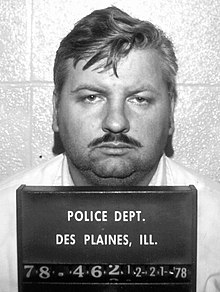Few names in the history of American crime evoke as much horror and fascination as John Wayne Gacy. Responsible for the brutal murders of at least 33 young men and boys, Gacy’s case has been widely studied and analyzed over the years. One of the most chilling aspects of this notorious crime spree is the crime scene photos that have emerged from this dark period.

Taking a closer look at these chilling images, we’re confronted with the horrifying extent of Gacy’s murderous acts. From the eerie suburban setting of his crimes to the hidden crawlspace beneath his home, these photos offer a haunting glimpse of the true nature of evil. So, while it’s important to be mindful of the disturbing content, there is undoubtedly much to be gleaned from a closer examination of these crime scene photos.
As we delve into the unsettling story of John Wayne Gacy, we’ll be discussing some of the most significant details and facts from his crime scenes. Our aim is to provide an objective, educational perspective on these troubling events, shedding light on this dark chapter in American criminal history.
Gruesome Glimpses: John Wayne Gacy’s Crime Scenes
John Wayne Gacy, also known as the Killer Clown, was a notorious American serial killer who took the lives of at least 33 young men and boys between 1972 and 1978. In this section, we’ll delve into the chilling crime scene photos that reveal the horrifying nature of Gacy’s heinous acts.
Despite his evil deeds, Gacy managed to maintain an image of a respected member of society while he committed his crimes. The crime scene photos illustrate this duality of Gacy’s life, with images of his house and his work as a Pogo the Clown. We’ll explore the eerie contrast between Gacy’s public persona and the NIGHTMARES he created for so many innocent victims.
In the 1970s, Gacy’s modest suburban home became a death trap for unsuspecting young men. Gacy would lure his victims to his house with the promise of a job, a drink, or even just a friendly conversation. Once there, he would strangle them with a rope and hide their remains. Crime scene photos show various rooms in his house, including the notorious crawl space, where he buried 26 of his victims:
- The living room, where he chatted with his victims before leading them to their doom
- The garage, where some victims were abducted, and Gacy’s infamous clown attire was discovered
- Gacy’s bedroom, where he committed many of his vile acts, including sexual assaults
- The crawl space, his macabre burial ground
| Years | Number of Victims |
|---|---|
| 1972-1978 | 33 |
Gacy’s crimes were not only limited to his house; he would also carry out his malicious acts in other locations, such as his workplace and his vehicles. Crime scene photographs further expose the shocking extent of his crimes, capturing:
- Gacy’s construction company office, where he attacked and murdered at least one of his workers
- His car, where some victims were abducted or transported to their final resting place
- The areas along the Des Plaines River, where Gacy dumped four of his victims
The horrifying photographs of Gacy’s crime scenes provide a grim reminder of the intensity and cold-heartedness of his actions. As fans of true crime mysteries, we can’t help but be captivated by the sheer implausibility of Gacy’s monstrous deeds. Studying these gruesome glimpses of his crimes enables us to better understand the complex and chilling nature of one of America’s most notorious serial killers.

Impact on Forensic Investigation Techniques
One significant aspect of the John Wayne Gacy case revolves around the impact it had on forensic investigation techniques. The gruesome crime scene and the sheer volume of evidence provided valuable insights for law enforcement and forensic investigators. In this section, we’ll discuss some of the noteworthy improvements in forensic investigation strategies that resulted from this case.
First and foremost, the Gacy case demonstrated the importance of proper evidence collection and preservation. Due to the number of victims and the state of decomposition at the crime scene, it became crucial to ensure the integrity of evidence for later analysis. As a result, crime scene investigators started to focus more on:
- Adhering to strict protocols to prevent contamination
- Properly labeling and documenting the evidence collected
- Developing improved methods to preserve biological evidence, such as freezing or vacuum-sealing
The challenges faced in identifying Gacy’s victims also changed the way forensic anthropology was used in criminal investigations. The forensic experts had to meticulously examine the skeletal remains in order to uncover the victims’ identities. This led to advancements in:
- Bone analysis techniques
- Age and gender estimation
- Dental comparison for identification purposes
Another major impact of this case was the increased use of forensic profiling. The ability to link seemingly unrelated cases by analyzing the behavioral patterns of a perpetrator proved extremely beneficial in catching Gacy. Profiling has since emerged as an important tool for investigators and has led to:
- More effective collaboration among different agencies
- Enhanced understanding of offender’s motives and characteristics
- Prompt identification of possible suspects based on their modus operandi
In conclusion, the John Wayne Gacy case significantly shaped the field of forensic investigation. It served as a catalyst for improvements in evidence preservation, forensic anthropology, and offender profiling. The advancements in these areas have greatly benefited law enforcement personnel and forensic investigators in solving complex criminal cases, such as those found within the realm of cold cases, crime, and mystery on MurderArchives.org.
Understanding the Mind of a Serial Killer
When examining John Wayne Gacy’s crime scene photos, we often find ourselves attempting to comprehend his motives and thought processes. It’s not an easy task, as serial killers tend to exhibit complex behaviors and psychological traits that can be difficult to grasp. To gain a better understanding of the mind of a serial killer, let’s delve into some significant factors that experts attribute to these chilling criminals.
One noteworthy aspect of serial killers is their strong desire for control. We see this in their choice of victims, methods of murder, and even the manner in which they dispose of the bodies. Serial killers often target vulnerable individuals who are less likely to resist or seek help. In Gacy’s case, his victims were primarily young men and boys. By controlling the circumstances of the crime and manipulating his victims, serial killers like Gacy maintain a sense of power.
Another key element is their emotional disconnection. It’s not uncommon for serial killers to exhibit an eerie ability to compartmentalize their actions, enabling them to live seemingly normal lives while committing heinous acts. In Gacy’s case, he was well-regarded within his community, and even performed as a clown for events. Researchers believe this disconnection may stem from various factors, such as childhood trauma or difficulty in empathizing with others.
A propensity for repeat offenses is another central trait of serial killers. Experts have identified some common factors that can contribute to the development of a serial killer’s urge to repeatedly commit murder:
- Fantasy: Many serial killers are driven by violent fantasies that become more vivid and pervasive over time. These fantasies can serve as a catalyst for their crimes and often become more elaborate with each offense.
- Reinforcement: The thrill, sense of control, or gratification a serial killer gains from their acts can create a compulsion to continue. It creates a vicious cycle that reinforces their behavior.
- Desensitization: With each kill, a serial killer may become increasingly desensitized to the suffering they cause, thereby making it easier for them to perpetrate even more violent acts.
It’s crucial, however, to remember that not all serial killers share the same motives or psychological profiles. While some commonalities exist, such as those mentioned above, substantial variation exists among different individuals who commit these horrifying crimes.
Through numerous case studies and advancements in forensic psychology, we have made progress toward understanding the complex inner workings of serial killers like John Wayne Gacy. Though we may never fully comprehend what drives individuals to commit such heinous acts, delving into the minds of these criminals helps us better identify potential triggers and patterns, aiding us in the pursuit of justice and prevention of future atrocities.
Controversy Surrounding Crime Scene Photography
Crime scene photography plays a crucial role in the investigation and documentation of criminal activities. However, sharing crime scene photos, especially those as grisly as John Wayne Gacy’s case, often stirs up debates regarding the ethical and moral implications. In this section, we’ll explore the controversy surrounding crime scene photography, focusing on matters concerning privacy and sensitivities surrounding the victims, their families, and the audience.
The first point of contention is the invasion of privacy. When crime scene photos are shared publicly, it exposes vulnerable moments in the lives of the victims and their families. It’s important to consider that placing these images on a public domain could lead to additional emotional trauma for the victim’s loved ones, who may encounter the photos inadvertently or unintentionally.
Another concern lies in the sensationalism of criminal cases. Displaying graphic crime scene images can inadvertently contribute to the glorification of the crime or the perpetrator. This often results in unnecessary attention to the criminal rather than honoring the memory of the victims. As a result, it’s a delicate balance between the necessity of information and the desire to avoid exploitative media coverage.
Including crime scene photographs in an article or blog post also raises ethical questions for content creators and writers. While it’s critical to provide accurate and informative content, there’s a blurred line between providing valuable insights and disrespecting the memory of those involved. It’s essential to decide whether the inclusion of graphic images enhances the understanding of the case or merely appeals to the darker curiosity of readers.

Moreover, crime scene photography should be handled and distributed responsibly by professionals involved in the process. Instances of leaked images, including unauthorized release or distribution, lead to further controversy and mistrust in the handling of sensitive material. Proper security measures and protocols should be in place to protect sensitive data and ensure they don’t fall into the wrong hands.
When discussing crime scene photographs, we must consider the following points:
- Balancing the need for accuracy and information with the respect for the victim’s privacy
- Avoiding sensationalism and glorification of the crime or the perpetrator
- Ethical implications for content creators, writers, and individuals handling crime scene photographs
- Maintaining security measures and protocols to prevent unauthorized access or distribution
In conclusion, while crime scene photography is an indispensable tool for investigations, there is an unavoidable controversy surrounding its public consumption. As we continue to explore and write about cases like John Wayne Gacy, it’s crucial to tread carefully and prioritize the integrity and ethical implications involved.
Conclusion: Lessons to Be Learned
Reflecting upon John Wayne Gacy’s crime scene photos, several significant lessons can be derived. These lessons, while centered around cold cases, crime, and mystery, hold substantial value for both the curious and the avid enthusiasts within our community at MurderArchives.org.
First and foremost, studying crime scene photos is crucial for understanding the extent of a criminal’s intent and modus operandi. They remind us of the essential role that visual evidence plays in solving cases, piecing together events, and bringing perpetrators to justice. With Gacy’s case, the photos served as undeniable proof of his gruesome actions and highlighted the urgency for forensic advancements:
- The importance of preserving and analyzing data
- Strengthening the use of forensics and technology
- Developing new methods for suspect identification and apprehension
Moreover, we’re reminded of the societal impact that such cases have, and the need for vigilance and communication within our communities. By seeking patterns and learning from past mistakes, we can contribute to creating a safer society:
- Encouraging neighborhood watch programs
- Implementing background checks for those working with vulnerable populations
- Establishing proper protocols for missing persons reports
Lastly, Gacy’s case highlights the difficulty in profiling criminals and the constant challenge of predicting their next move. It’s a testament to the unpredictability of human behavior and a reminder that anyone can harbor dark secrets:
- Ensuring continuous education and training for law enforcement and profilers
- Sharing knowledge and experiences between professionals in the field
- Encouraging open discussions surrounding mental health and societal pressures
By examining the conclusion of the John Wayne Gacy case, we have an opportunity to learn from history; this knowledge aids our continuous quest for justice and a better understanding of the criminal mind.
References:
https://www.britannica.com/biography/John-Wayne-Gacy

Owner & entrepreneur with a passion for murder mystery! Seriously, who doesn’t love murder mystery?
Chris is a proud member of the American Medical Writer’s Association (AMWA), the International Society for Medical Publication Professionals (ISMPP), the National Association of Science Writers (NASW), the Council of Science Editors, the Author’s Guild, and the Editorial Freelance Association (EFA).

